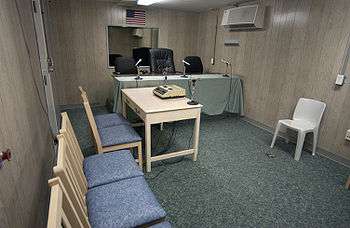Abdel Malik Ahmed Abdel Wahab Al Rahabi
| Abdel Malik Ahmed Abdel Wahab Al Rahabi | |
|---|---|
 | |
| Arrested |
December 2001 Pakistan border crossing Pakistani border guards |
| Released |
2016-06-22 Montenegro |
| Citizenship | Yemen |
| Detained at | Guantanamo |
| Alternate name |
|
| ISN | 37 |
| Charge(s) | no charge, extrajudicial detention |
| Status | granted asylum |
Abdel Malik Ahmed Abdel Wahab al Rahabi is a citizen of Yemen who was held in extrajudicial detention by the United States from December 2001 to June 22, 2016.[1][2] He was one of the first twenty captives transferred to the Guantanamo Bay detention camps, in Cuba, on January 11, 2001, and was held there until he was transferred to Montenegro, which granted him political asylum.[3][4][5][6][7][8][9][10][11][12][13]
One of the allegations US intelligence analysts used to justify his detention was that he was captured with a group of thirty Osama bin Laden bodyguards. Historian Andy Worthington, author of The Guantanamo Files, has criticized this allegation as it required taking at face value the denunciations of captives who lacked credibility.
Al Rahabi was a married man when he was captured. His wife had just given birth to a daughter.[1][2] Al Rahabi was one of the camp's most determined hunger strikers.[14]
Official status reviews
Originally the Bush Presidency asserted that captives apprehended in the "war on terror" were not covered by the Geneva Conventions, and could be held indefinitely, without charge, and without an open and transparent review of the justifications for their detention.[15] In 2004 the United States Supreme Court ruled, in Rasul v. Bush, that Guantanamo captives were entitled to being informed of the allegations justifying their detention, and were entitled to try to refute them.
Office for the Administrative Review of Detained Enemy Combatants

Following the Supreme Court's ruling the Department of Defense set up the Office for the Administrative Review of Detained Enemy Combatants.[15][18]
Scholars at the Brookings Institution, led by Benjamin Wittes, listed the captives still held in Guantanamo in December 2008, according to whether their detention was justified by certain common allegations:[19]
- Abd Al Malik Abd Al Wahab was listed as one of the captives who the military alleges were members of either al Qaeda or the Taliban and associated with the other group.[19]
- Abd Al Malik Abd Al Wahab was listed as one of the captives who "The military alleges ... took military or terrorist training in Afghanistan."[19]
- Abd Al Malik Abd Al Wahab was listed as one of the captives who "The military alleges ... served on Osama Bin Laden's security detail."[19]
- Abd Al Malik Abd Al Wahab was listed as one of the captives who was an "al Qaeda operative".[19]
- Abd Al Malik Abd Al Wahab was listed as one of the "34 [captives] admit to some lesser measure of affiliation—like staying in Taliban or Al Qaeda guesthouses or spending time at one of their training camps."[19]
- Abd Al Malik Abd Al Wahab was listed as one of the captives who had admitted "some form of associational conduct."[19]
Formerly secret Joint Task Force Guantanamo assessment
On April 25, 2011, whistleblower organization WikiLeaks published formerly secret assessments drafted by Joint Task Force Guantanamo analysts.[20][21] His eleven-page Joint Task Force Guantanamo assessment was drafted on April 28, 2008.[22] It was signed by camp commandant Rear Admiral Mark H. Buzby. He recommended continued detention.
Asylum in Montenegro
The government of Montenegro accepted al Rahabi on June 22, 2016.[1][3][5][6][7][8][9][10][11][12][13] They explicitly went on record saying that he would be entitled to leave Montenegro and said that giving him asylum would not be a financial burden on Montenegro.[4]
References
- 1 2 3 Carol Rosenberg (2016-06-22). "Guantánamo detainee since Day 1 is released to Montenegro after 14 years". Miami Herald. Archived from the original on 2016-06-23. Retrieved 2016-06-23.
Montenegro said Yemeni Abdel Malik al Rahabi applied for asylum and could some day choose to leave the Balkan nation
- 1 2 Carol Rosenberg (2016-06-22). "Another Yemeni 'forever prisoner' at Guantánamo is cleared for release". Miami Herald. Archived from the original on 2016-06-03. Retrieved 2016-06-23.
Now the government’s Periodic Review Board has decided he can be released, if security conditions permit. The board earlier ruled in March that it was too risky to release him because of unrest in his hometown in Yemen and the fact that he has a brother-in-law with ties to extremists.
But a board decision released Tuesday says he can be released if certain safeguards are imposed. It’s not clear whether he will be returned to Yemen or resettled elsewhere. - 1 2 Ben Fox (2016-06-22). "US starts expected series of releases from Guantanamo prison". Associated Press. Archived from the original on 2016-06-23. Retrieved 2016-06-24.
While in custody, al-Rahabi studied English, worked with military officials to help ease tensions in the detention center and worked with several fellow prisoners on an extensively detailed plan for a post-Guantanamo agricultural enterprise, the "Yemen Milk and Honey Farms Limited," according to his lawyer, David Remes.
- 1 2 "Montenegro receives another person within humanitarian programme of re-socialisation of prisoners from Guantanamo". Government of Montenegro. 2016-06-22. Archived from the original on 2016-06-23.
- 1 2 Alexander Smith, Emily Gaffney (2016-06-23). "Alleged Bin Laden Bodyguard Transferred From Gitmo to Montenegro". NBC News. Archived from the original on 2016-06-23. Retrieved 2016-06-24.
A Guantanamo detainee once accused of being Osama bin Laden's bodyguard and planning to hijack airliners on 9/11 has been released and transferred to Montenegro, the Department of Defense said Wednesday.
- 1 2 Kate Scanlon (2016-06-23). "Obama admin takes unilateral gitmo action while media focused on democrats gun control protest". The Blaze. Archived from the original on 2016-06-24.
- 1 2 Harry Cockburn (2016-06-23). "Man accused of being Osama bin Laden's bodyguard released from Guantanamo Bay after 14 years". The Independent (UK). Archived from the original on 2016-06-23. Retrieved 2016-06-24.
Lee Wolosky, the special envoy for Guantanamo closure at the State Department, said the US government was grateful to Montenegro for accepting the former prisoner.
- 1 2 "Detainee Transfer Announced". US Department of Defense. 2016-06-22. Retrieved 2016-06-24.
The United States is grateful to the Government of Montenegro for its humanitarian gesture and willingness to support ongoing U.S. efforts to close the Guantanamo Bay detention facility. The United States coordinated with the Government of Montenegro to ensure this transfer took place consistent with appropriate security and humane treatment measures.
- 1 2 "Pentagon Sends Yemeni Guantanamo Prisoner To Montenegro". Radio Free Europe. 2016-06-23. Retrieved 2016-06-24.
U.S. officials cleared Abdel Malik Abdel Wahab al-Rahabi for release in March 2014, but the Obama administration does not send Guantanamo prisoners back to Yemen because of the civil war there. It took two years to find another government which would take in the former Al-Qaeda bodyguard.
- 1 2 "Yemeni man accused of being Bin Laden bodyguard released from Guantanamo". al Bawaba. 2016-06-23. Archived from the original on 2016-06-24.
- 1 2 "Yemeni Gitmo inmate transferred to Montenegro". The Nation (Pakistan). 2016-06-24. Archived from the original on 2016-06-24.
According to leaked files published by WikiLeaks and the New York Times, Rahabi is from Yemen, had been a bodyguard for Osama bin Laden and was related by marriage to the former Al-Qaeda leader. Born in 1979, Rahabi was captured in December 2001 among a group of 31 other Al-Qaeda fighters referred to by US intelligence agents as the “Dirty 30,” documents state. “The United States is grateful to the government of Montenegro for its humanitarian gesture and willingness to support ongoing US efforts to close the Guantanamo Bay detention facility,” the Pentagon said.
- 1 2 Curt Mills (2016-06-23). "Detainee Released From Gitmo to Montenegro". US News and World Report. Retrieved 2016-06-24.
Al-Rahab is the second Guantanamo prisoner sent to Montenegro this year, and is expected to set off a new round of releases from the facility, the International Business Times reports.
- 1 2 Seerat Chabba (2016-06-23). "Guantanamo Detainee Transferred To Montenegro As Obama Pushes To Close Detention Center". International Business Times. Archived from the original on 2016-06-24.
Al Rahabi is the second prisoner to be resettled in Montenegro this year as Obama tries to reduce the number of men held at Guantanamo, Cuba. This marked the start of what is expected to be a new round of releases from the U.S. base even as the Congress continues to prevent the closure of the detention center with a prohibition on transferring prisoners to the United States.
- ↑ Carol Rosenberg (2013-07-17). "Twentyfour force-fed captives". Miami Herald. Archived from the original on 2015-10-03. Retrieved 2016-06-23.
In March, according to his lawyer David Remes, Wahab, who last saw his daughter as an infant, vowed to fast until he got out of the prison "either dead or alive."
- 1 2 "U.S. military reviews 'enemy combatant' use". USA Today. 2007-10-11. Archived from the original on 2012-08-11.
Critics called it an overdue acknowledgment that the so-called Combatant Status Review Tribunals are unfairly geared toward labeling detainees the enemy, even when they pose little danger. Simply redoing the tribunals won't fix the problem, they said, because the system still allows coerced evidence and denies detainees legal representation.
- ↑ Guantánamo Prisoners Getting Their Day, but Hardly in Court, New York Times, November 11, 2004 - mirror
- ↑ Inside the Guantánamo Bay hearings: Barbarian "Justice" dispensed by KGB-style "military tribunals", Financial Times, December 11, 2004
- ↑ "Q&A: What next for Guantanamo prisoners?". BBC News. 2002-01-21. Archived from the original on 23 November 2008. Retrieved 2008-11-24.
- 1 2 3 4 5 6 7 Benjamin Wittes, Zaathira Wyne (2008-12-16). "The Current Detainee Population of Guantánamo: An Empirical Study" (PDF). The Brookings Institution. Retrieved 2010-02-16. mirror
- ↑ Christopher Hope; Robert Winnett; Holly Watt; Heidi Blake (2011-04-27). "WikiLeaks: Guantanamo Bay terrorist secrets revealed -- Guantanamo Bay has been used to incarcerate dozens of terrorists who have admitted plotting terrifying attacks against the West – while imprisoning more than 150 totally innocent people, top-secret files disclose". The Telegraph (UK). Archived from the original on 2012-07-13. Retrieved 2012-07-13.
The Daily Telegraph, along with other newspapers including The Washington Post, today exposes America's own analysis of almost ten years of controversial interrogations on the world's most dangerous terrorists. This newspaper has been shown thousands of pages of top-secret files obtained by the WikiLeaks website.
- ↑ "WikiLeaks: The Guantánamo files database". The Telegraph (UK). 2011-04-27. Archived from the original on 2015-06-26. Retrieved 2012-07-10.
- ↑ "Abd Al Malak Abd Al Wahab Al Rahbi: Guantanamo Bay detainee file on Abd Al Malak Abd Al Wahab Al Rahbi, US9YM-000037DP, passed to the Telegraph by Wikileaks". The Telegraph (UK). 2011-04-27. Retrieved 2016-06-23.